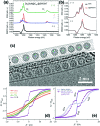Recent advances in single molecule magnetism of dysprosium-metallofullerenes
- PMID: 30756104
- PMCID: PMC6394203
- DOI: 10.1039/c8dt05153d
Recent advances in single molecule magnetism of dysprosium-metallofullerenes
Abstract
This article outlines the magnetic properties of single molecule magnets based on Dy-encapsulating endohedral metallofullerenes. The factors that govern these properties, such as the influence of different non-metal species in clusterfullerenes, the cage size, and cage isomerism are discussed, as well as the recent successful isolation of dimetallofullerenes with unprecedented magnetic properties. Finally, recent advances towards the organization of endohedral metallofullerenes in 1D, 2D, and 3D ordered structures with potential for devices are reviewed.
Figures








References
-
- Sessoli R., Gatteschi D., Caneschi A., Novak M. A. Nature. 1993;365:141.
- Gatteschi D., Sessoli R. and Villain J., Molecular Nanomagnets, Oxford University Press, New York, 2006.
- Introduction to Molecular Magnetism: From Transition Metals to Lanthanides, ed. Benelli C. and Gatteschi D., Wiley-VCH Verlag GmbH & Co. KGaA, Weinheim, 2015.
-
- Sorace L., Benelli C., Gatteschi D. Chem. Soc. Rev. 2011;40:3092. - PubMed
- Zhang P., Guo Y.-N., Tang J. Coord. Chem. Rev. 2013;257:1728.
- Liddle S. T., van Slageren J. Chem. Soc. Rev. 2015;44:6655. - PubMed
- Zhu Z., Guo M., Li X.-L., Tang J. Coord. Chem. Rev. 2019;378:350.
- Liu J.-L., Chen Y.-C., Tong M.-L. Chem. Soc. Rev. 2018;47:2431. - PubMed
- Ishikawa N., Sugita M., Ishikawa T., Koshihara S., Kaizu Y. J. Am. Chem. Soc. 2003;125:8694. - PubMed
- Giraud R., Wernsdorfer W., Tkachuk A. M., Mailly D., Barbara B. Phys. Rev. Lett. 2001;87:057203. - PubMed
- Woodruff D. N., Winpenny R. E. P., Layfield R. A. Chem. Rev. 2013;113:5110. - PubMed
- Rinehart J. D., Long J. R. Chem. Sci. 2011;2:2078.
-
- Goodwin C. A. P., Ortu F., Reta D., Chilton N. F., Mills D. P. Nature. 2017;548:439. - PubMed
- Guo F.-S., Day B. M., Chen Y.-C., Tong M.-L., Mansikkamäki A., Layfield R. A. Angew. Chem., Int. Ed. 2017;56:11445. - PubMed
- Guo F.-S., Day B. M., Chen Y.-C., Tong M.-L., Mansikkamäki A., Layfield R. A. Science. 2018;362:1400. - PubMed
- McClain K. R., Gould C. A., Chakarawet K., Teat S., Groshens T. J., Long J. R., Harvey B. G. Chem. Sci. 2018;9:8492. - PMC - PubMed
-
- Westerström R., Dreiser J., Piamonteze C., Muntwiler M., Weyeneth S., Brune H., Rusponi S., Nolting F., Popov A., Yang S., Dunsch L., Greber T. J. Am. Chem. Soc. 2012;134:9840. - PubMed
LinkOut - more resources
Full Text Sources

